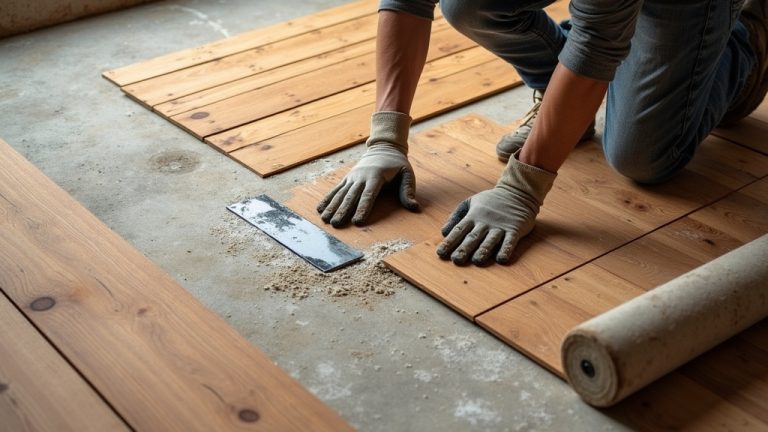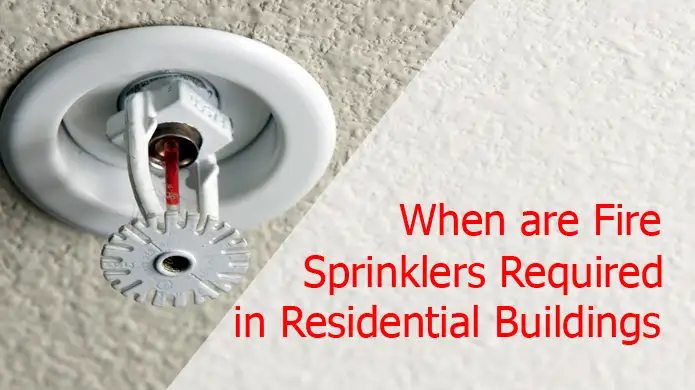How to Get Oil Off Hardwood Floors: 2 Methods [DIY]
Hardwood floors are popular among homeowners due to their natural beauty and durability. But oil spills can happen, and the challenge of removing sticky grease can be daunting when cleaning oil spills on hardwood floors.
Oil stains affect your floor’s appearance, making it slippery and unsafe for walking. Remove oil spills immediately to avoid accidents and preserve your hardwood floor’s beauty.
You can easily clean up fresh oil spills by applying vinegar solution, whipping and rinsing the area, or using the oxalic acid solution for stubborn and dried spills.
Today we will discuss easy steps to get oil off hardwood floors. Also, we will explore other solutions that effectively dissolve old oil stains on hardwood floors. So continue reading.
How to Get Oil Off Hardwood Floors: 2 Easy Methods to Follow
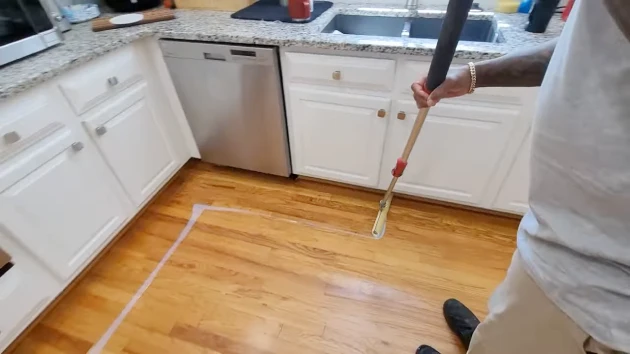
Oil spills can be disastrous for hardwood floors, leaving unsightly stains and compromising the integrity of the wood. However, getting oil off hardwood floors can be fairly simple with the right technique. Here are some methods to follow:
Method #1 Removing Fresh Oil from Hardwood Floors
When dealing with fresh oil stains on hardwood floors, several easy steps can be taken to remove the oil effectively.
Step 1. Remove Excess Oil
It is recommended to use either a paper towel or an absorbent cloth to eliminate any excess oil from the surface of the wooden flooring. This will ensure that the subsequent cleaning steps are more effective.
Simply place a paper towel or a soft absorbent cloth over the affected area and press firmly to soak up any excess oil.
Repeat this process until you have removed as much of the spilled oil as possible. Once you have removed all excess oil, proceed with further cleaning steps according to your preferred method.
Step 2. Apply the Vinegar Solution
Applying the vinegar solution can effectively break down residual grease on wooden surfaces, leaving them clean and refreshed, coincidentally improving the overall aesthetic appeal of the space.
To properly apply this solution to hardwood floors, follow these steps:
- Pour undiluted white vinegar into a spray bottle.
- Mist the entire area, focusing on oily spots.
- Be sure to cover all areas evenly to ensure even cleaning.
- Let the vinegar sit for 5-10 minutes to break down the grease.
- This will give enough time for the vinegar to penetrate and dissolve any remaining oil residue.
Step 3. Wipe the Area
To complete the cleaning process, it is recommended to use a clean towel to wipe the area after allowing the vinegar solution to sit for a few minutes. This step will help remove any remaining oil residue and ensure the hardwood floor is clean and polished.
It is important to wipe and avoid applying too much pressure gently, as this may damage the floor’s surface.
Step 4. Rinse the area
To ensure thorough cleaning, using a fresh towel or mop is imperative to rinse the designated area with water meticulously. This step is crucial in removing any remaining traces of oil from hardwood floors and preventing further damage.
It is important to rinse clean water as dirty water may leave residue and make the floor appear dull. Also, excessive moisture can cause warping or cupping of hardwood floors, so it is essential to wring out excess water from the towel or mop before rinsing.
Step 5. Dry the Area
The next step in the process involves drying the designated area using a clean and absorbent towel.
Ensure all excess water has been removed from the surface before proceeding with any other treatment. A fan can also be used to facilitate drying, but care should be taken not to direct it too closely at one spot as this may cause additional damage.
Once the area has been thoroughly dried, it is recommended that a wood floor cleaner or polish be applied to restore its natural shine and protect it from further damage.
Method #2 Removing Dried Oil from Hardwood Floors
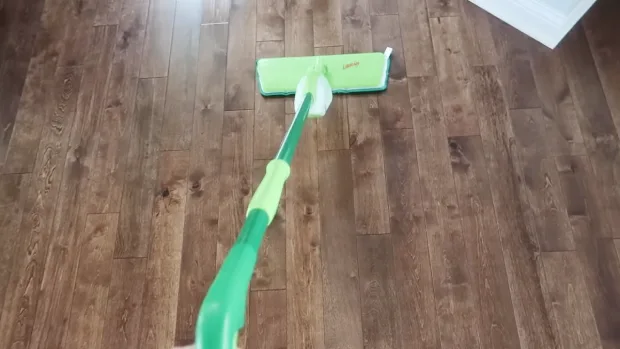
To remove dried oil from hardwood floors, several steps can be taken:
Step 1. Use Dry-Cleaning Fluid
Removing the oily residue from hardwood flooring can be effectively accomplished by applying two to three drops of dry-cleaning spot remover. It should be gently scrubbed into the affected area using a soft-bristled scrub brush. This method is especially useful for removing dried oil from hardwood floors.
To ensure successful removal, follow these steps:
- Dampen the oil spot with three drops of dry-cleaning remover;
- Let it sit for a few minutes to allow the solution to penetrate the wood;
- Gently scrub the affected area with a soft-bristled scrub brush in circular motions;
- Wipe up any excess fluid with a clean cloth.
Step 2: Prepare Oxalic Acid Solution
Mix equal parts oxalic acid and distilled water using a microwave-safe glass jar, and microwave the mixture for 30 seconds until it becomes warm. This solution is an effective way to remove oil stains from hardwood floors.
Oxalic acid breaks down the oil molecules, making them easier to clean. Handling oxalic acid carefully is important as it can cause skin irritation and should not be ingested.
Also, wearing gloves and protective eyewear when handling this solution is recommended. Once prepared, the oxalic acid solution can be applied directly onto the stained area using a soft cloth or brush.
Step 3: Apply the Oxalic Acid Mixture
After preparing the oxalic acid mixture, the next step is to apply it to the oil stains on hardwood floors. This can be done by using a brush to evenly stroke and saturate the spot until it is thoroughly covered.
Ensuring that every inch of the stain is coated with the mixture is important to remove the oil effectively. The application process should be done carefully and patiently, giving enough time for the mixture to penetrate the hardwood floor.
Once applied, allow it to sit for some minutes before wiping it off with a clean cloth or mop. However, caution must be taken when handling oxalic acid as it can cause skin irritation or burns if not handled properly. Thus, protective gloves should always be worn during this process to avoid harm.
Step 4: Heat and Brush
Heat the mixture and carefully brush it onto every inch of the hardwood floor to ensure that any discoloration remnants are banished. The heat will activate the oxalic acid solution, making it more effective in breaking down the oil stains.
Brushing also helps to distribute the mixture evenly on the surface of the wood. Here are some tips to follow when using this method:
- Use a soft-bristled brush to avoid damaging the wood
- Work in small sections to prevent drying out of the mixture before you have had time to brush it properly
Step 5: Remove the Neutralizer
The final step in the oil stain removal process involves wiping the neutralizing mixture from the hardwood floors with a clean damp cloth. It allows them to air-dry.
It is important to use a clean cloth that has been dampened in cool water to ensure the mixture is completely removed. After wiping away the mixture, it is recommended to pat excess moisture off the floors with a towel before allowing them to air dry.
Allowing adequate time for the floors to dry completely before walking on them or placing any furniture back on top is crucial.
Step 6: Sand the Spot
To effectively restore a bleached spot on hardwood floors, it is recommended to carefully sand the raised area with fine sandpaper. The wood grain tends to be raised by oxalic acid, which homeowners may find unsettling.
After neutralizing the surface and drying it thoroughly, use fine sandpaper to rub over the raised area for several passes gently. Rubbing with the wood grain is crucial until the raised area becomes level with the surrounding wood.
This step will help to remove any excess residue from the oil spill that previous cleaning methods may not have removed. Sanding also helps to prepare the affected area for refinishing or re-staining, if necessary.
Step 7: Brush On Wood Stain
Brushing on the wood stain is a critical step in restoring bleached spots on hardwood floors. It helps to match the color of the affected area with that of the surrounding wood.
Here are some things to keep in mind when applying wood stain:
- Use a brush instead of a rag or cloth to apply the stain. This will help you achieve an even coat and prevent streaks or blotches.
- Apply the stain in thin layers and allow each layer to dry completely before adding another. This will prevent the color from becoming too dark or uneven.
Other Solutions to Dissolve Old Oil Spills on Hardwood Floors
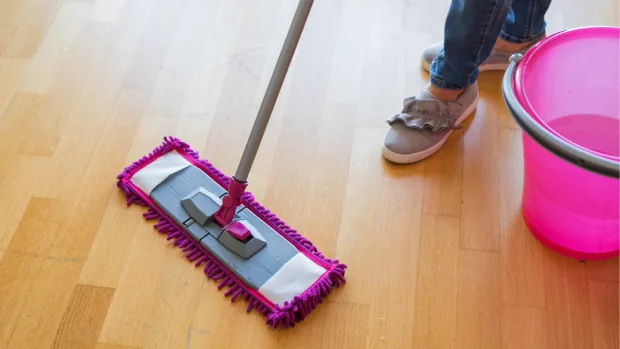
There are several solutions to consider when removing old oil spills on hardwood floors.
#1 Use Trisodium Phosphate (TSP) for Wax-Finished Floor
Trisodium phosphate (TSP) effectively removes unwanted wax buildup on hardwood flooring, providing a renewed shine that will impress. TSP is an alkaline cleaning agent used for various household cleaning purposes, including paint prep and degreasing.
It works by breaking down the wax finish on the hardwood surface, enabling easy removal of the oil stain. To use TSP for a wax-finished floor:
- Mix a small amount of TSP with warm water according to the manufacturer’s instructions.
- Apply the solution to the affected area using a clean cloth or sponge.
- Allow it to sit for several minutes before scrubbing it gently with a soft-bristled brush.
- Rinse thoroughly with clean water and dry completely.
#2 Use Odorless Mineral Spirits for a Surface-Finished Floor
Odorless mineral spirits are a highly effective cleaning agent for removing surface finishes on hardwood flooring. These spirits are paint thinner specifically designed to dissolve oils and other contaminants from surfaces.
Unlike traditional solvents, odorless mineral spirits do not emit harmful vapors or leave unpleasant odors. It makes them a safe and convenient option for indoor use.
To use odorless mineral spirits on your hardwood floor, apply a small amount of the solvent onto a clean cloth or rag. Then, gently rub the affected area in circular motions until the oil stain starts to lift off the surface.
Working carefully and avoiding too much pressure is important, as this may damage the wood finish. Once you have removed the stain, rinse the area with warm water and dry it thoroughly using another clean cloth.
#3 Use Fuller’s Earth Powder for Stubborn Oil Spills
Fuller’s earth powder is a highly effective cleaning agent for stubborn oil spills on hardwood flooring. This natural clay material is composed of calcium montmorillonite and other minerals, which give it exceptional adsorption properties.
When applied to an oil spill, Fuller’s earth powder works by binding with the oil molecules and removing them from the surface of the hardwood floor.
To use Fuller’s earth powder for an oil spill on hardwood floors, apply a generous amount directly onto the affected area. Leave it there for several hours or overnight to thoroughly absorb the oil. Then, simply sweep or vacuum up the powder residue and dispose of it properly.
Repeat as necessary until all traces of the oil are removed from your hardwood floor. Fuller’s earth powder is a safe and effective alternative to harsh chemicals that may damage your hardwood floors while effectively removing stubborn grease stains.
Does baking soda remove oil from the hardwood floor surface?

Baking soda can effectively eliminate grease from the surface of hardwood floors by creating a thick layer that sits on top of the stain and draws out the oil over a period of 30-45 minutes.
When used as a cleaning agent, baking soda reacts with the oil and breaks it down into smaller particles, making it easier to remove hardwood floors from the surface. This method is very effective for removing small amounts of oil spills.
However, baking soda may only be able to remove some traces of oil from your hardwood floor if it has been left unattended for a short time or if there are multiple layers of grease.
Can oil damage hardwood floors?
The presence of cooking oil and greasy or oily food can cause damage to the surface of wooden floors. When oil is spilled on hardwood floors, it seeps into the wood’s pores and can cause discoloration or staining. Moreover, if not cleaned immediately, it becomes harder to remove as time passes.
Oil penetration on hardwood floors may also lead to long-term damage, such as warping or buckling. Also, if left untreated for an extended period, oil buildup can attract dirt and grime, making cleaning even more difficult.
What should you not do to an oiled wooden floor?
Steam cleaners and scrubber dryers should be shunned when it comes to maintaining oiled wooden floors. These cleaning tools can cause significant damage to the surface of the wood, which could result in costly repairs.
The high temperature and moisture produced by steam cleaners can weaken the protective layer of oil on hardwood floors, causing it to break down over time. Similarly, scrubber dryers use abrasive pads that can scratch an oiled floor’s finish, exposing it to further damage.
Don’t Let Oil Spills Damage Your Hardwood Floors: Clean Oil Spills Quickly
While oil will not necessarily ruin hardwood floors, it can cause discoloration and affect the finish if left untreated for too long. Therefore, prompt action is crucial in preventing any damage from occurring.
Removing oil spills from hardwood floors is a daunting task that requires patience and care. The process involves using absorbent materials, cleaning solutions, and gentle scrubbing to ensure the surface is not damaged.
Try to avoid using harsh chemicals or abrasive tools as they can scratch or discolor the wood. Baking soda can remove oil stains but may not be effective for old spills.
Remember, with careful handling and attention, you can restore your beautiful hardwood floors to their original luster again.


